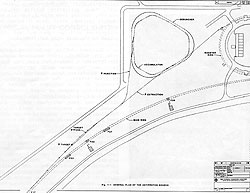Tev I Antiproton Source Moves Ahead
The people of the Antiproton Source Section have been very busy and productive in the last several months. Their hard work culminated in a Design Report issued just before the beginning of March, a detailed cost estimate of the entire project, and two intensive reviews of the project. Everyone in the section had a hand in these events, under the leadership of John Peoples, Don Young, and Fred Mills. Sue Grommes of the Director's Office and Teri Martin typed endless drafts, giving the CYBER word-processing system one of its tougher workouts.
In addition to the antiproton source, the Tevatron I project includes additional refrigeration, special magnets, and rf systems to make the Energy Saver into a 1-TeV (trillion electron volt) accelerator and storage ring, the Tevatron, as well as building and conventional facilities at B0 for the Collider Detector. But the centerpiece of the project is producing and accumulating antiprotons, then accelerating them to 1 TeV going the other way around the Main Ring and Tevatron, so that bunches of 1-TeV protons and bunches of 1-TeV antiprotons collide in the detector. The goal is to produce and study the elusive "intermediate bosons," the W and Z particles, that will be a large step toward a more complete picture of the elementary particles we study at Fermilab.
What is presented in the new Design Report is a completely new design making use of "stochastic" cooling to shrink the antiproton beam to a tighter size so that it will fit in the Main Ring and Saver and to make more collisions. The old design, done a year ago, needed 12 hours to collect enough antiprotons to reach the luminosity goal (lO30cm-2sec-1) the designers set for themselves. The luminosity is a measure of how many events collisions will produce. The new design does the job in less than 5 hours. It also has better ways of being expanded to higher luminosities as we learn how to use them.
The new design includes a new target station to produce 8-GeV antiprotons from 125-GeV protons. The antiprotons are injected into a Debuncher ring to be built south of the Booster. In it, the beam will be given some initial cooling, then transferred to an Accumulator ring concentric with the Debuncher. Here we will stack successive batches of antiprotons, cooling them with 6 separate stochastic systems, until there is enough beam cooled to a high enough density. Then the antiprotons will be taken out and accelerated in the Main Ring and Tevatron.
The new better performance doesn't come for nothing. The estimated cost of the Tevatron I project has gone up. But it is a better, more solid project. Two review committees have examined the design in great detail. The first, a group put together by Leon Lederman to advise him, endorsed the project as sound technically. The second, a Department of Energy Committee, led by Maury Tigner, met here all last week. Their report is not available as yet, but the Fermilab antiproton people feel we did a good job of defending our work.
The schedule calls for beginning construction work this summer at B0, to mesh with the Energy Saver schedule, then to begin building the Antiproton Source next fiscal year. It won't be easy - the schedule is tight and there are many technical components to build and assemble, but the goal of proton-antiproton collisions at 2 TeV, the highest energy in the world through at least the 1980's, keeps the Antiproton Source Section working hard to get there.



